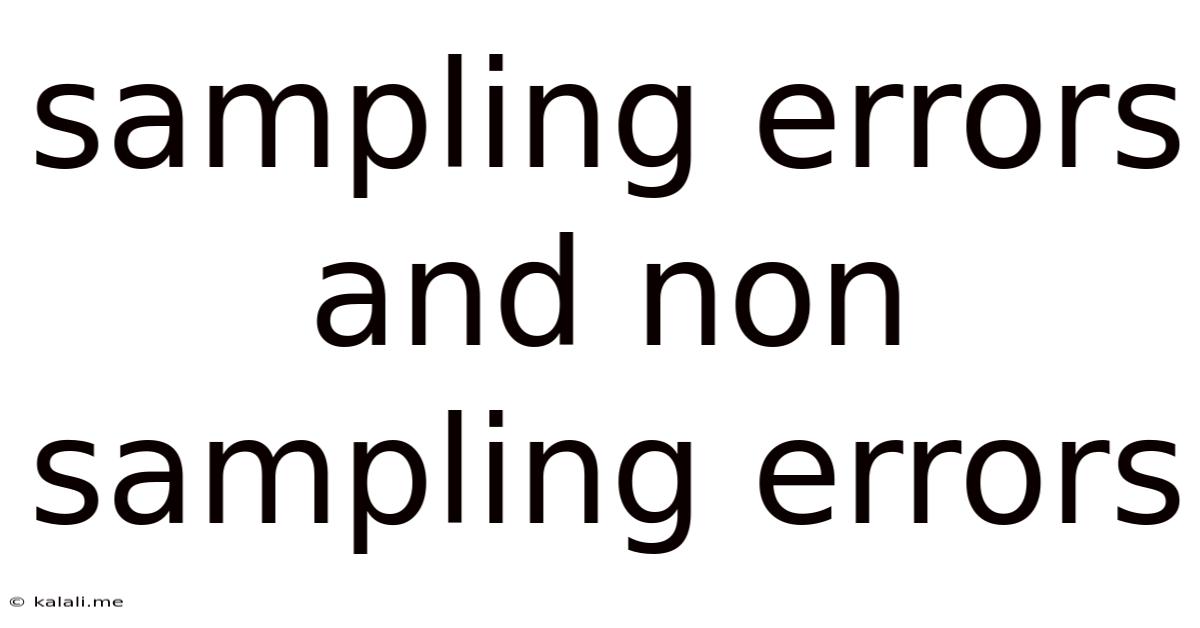Sampling Errors And Non Sampling Errors
Kalali
Jun 11, 2025 · 4 min read

Table of Contents
Sampling Errors and Non-Sampling Errors: A Comprehensive Guide
Meta Description: Understand the crucial difference between sampling errors (random variations) and non-sampling errors (systematic flaws) in data collection. Learn how to minimize both for accurate research results. This guide explores definitions, examples, and mitigation strategies for both types of errors.
Data collection is the cornerstone of any robust research project. However, even the most meticulously planned studies are susceptible to errors. These errors can be broadly categorized into two main types: sampling errors and non-sampling errors. Understanding the distinction between these error types is crucial for interpreting research findings accurately and improving the reliability of your data.
What are Sampling Errors?
Sampling errors occur due to the inherent variability present when a sample is taken from a larger population. Essentially, it's the difference between the characteristics of your sample and the characteristics of the entire population you're trying to study. This difference arises because a sample, by its nature, cannot perfectly represent the whole population. Even with perfect sampling techniques, some level of discrepancy is expected. Think of it as the random variation inherent in the sampling process.
Key Characteristics of Sampling Errors:
- Random in nature: They are unpredictable and occur by chance.
- Reducible but not eliminable: While they can be minimized by increasing sample size and using appropriate sampling methods, they cannot be completely eliminated.
- Statistical in nature: They can be measured and quantified using statistical methods.
Examples of Sampling Errors:
- Selecting a sample of university students to represent the entire adult population. This sample will likely skew towards younger individuals and specific demographics.
- Surveying only people who respond to an online questionnaire, ignoring those who choose not to participate (resulting in non-response bias, a type of sampling error).
- Using a convenience sample (e.g., surveying only your friends). This method leads to a sample that is unlikely to be representative of the larger population.
Minimizing Sampling Errors
Several strategies can help minimize sampling errors:
- Increase sample size: Larger samples generally provide a more accurate representation of the population.
- Use appropriate sampling techniques: Employing probability sampling methods like simple random sampling, stratified sampling, or cluster sampling ensures every member of the population has a known chance of being selected.
- Employ statistical methods: Utilize statistical techniques to analyze data and account for sampling variability. Confidence intervals and margin of error calculations are essential in this process.
What are Non-Sampling Errors?
Non-sampling errors, unlike sampling errors, are not related to the sampling process itself. They are systematic errors that occur due to flaws in the design or execution of the study. These errors can significantly bias the results and make it difficult to draw accurate conclusions.
Key Characteristics of Non-Sampling Errors:
- Systematic in nature: They are consistent and predictable, arising from a specific source.
- Potentially eliminable: They can often be avoided by careful planning and execution of the research.
- Difficult to quantify: Their impact is harder to measure compared to sampling errors.
Examples of Non-Sampling Errors:
- Measurement error: Inaccurate or inconsistent measurements (e.g., using a faulty scale to weigh objects).
- Data entry error: Mistakes made while recording or entering data.
- Interviewer bias: The interviewer influencing the respondent's answers through their behavior or questions.
- Response bias: Respondents providing inaccurate answers due to social desirability bias, recall bias, or other factors.
- Coverage error: A part of the population is excluded from the sampling frame.
- Selection bias: Systematic error in selecting the sample.
Minimizing Non-Sampling Errors
Minimizing non-sampling errors requires meticulous attention to detail throughout the research process:
- Careful study design: Develop a well-structured research plan that addresses potential sources of error.
- Well-trained interviewers: Provide thorough training to interviewers to ensure consistent data collection and avoid bias.
- Standardized questionnaires: Use clear, concise, and unbiased questionnaires to avoid ambiguity and response bias.
- Data validation and cleaning: Implement rigorous data checking and cleaning procedures to identify and correct errors.
- Pilot testing: Conduct a pilot study to test the research methodology and identify potential problems before full-scale implementation.
Conclusion
Both sampling and non-sampling errors can significantly impact the accuracy of research findings. While sampling errors are inherent to the sampling process and can be reduced but not eliminated, non-sampling errors are often preventable through careful planning and execution. By understanding the nature of these errors and implementing appropriate mitigation strategies, researchers can enhance the reliability and validity of their data and draw more accurate conclusions. Remember, minimizing both types of errors is crucial for producing high-quality research.
Latest Posts
Latest Posts
-
How Long Would It Take To Drive 2000 Miles
Jul 01, 2025
-
What Color Does Black And Blue Make
Jul 01, 2025
-
How To Pass Level 7 In Bloxorz
Jul 01, 2025
-
How Much Years Is 1 Billion Minutes
Jul 01, 2025
-
I Reject Your Reality And I Substitute My Own
Jul 01, 2025
Related Post
Thank you for visiting our website which covers about Sampling Errors And Non Sampling Errors . We hope the information provided has been useful to you. Feel free to contact us if you have any questions or need further assistance. See you next time and don't miss to bookmark.